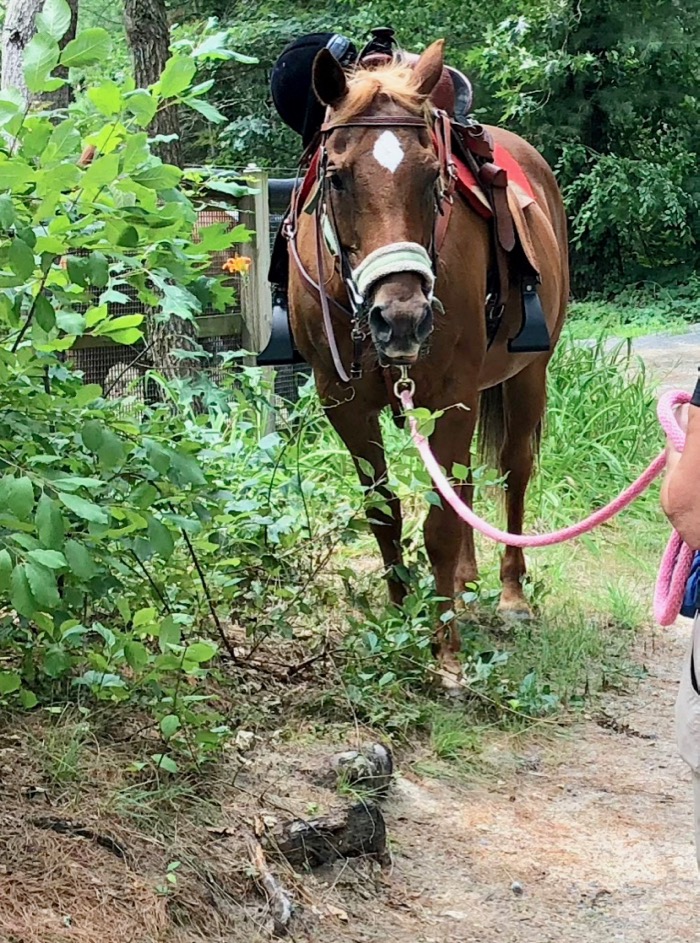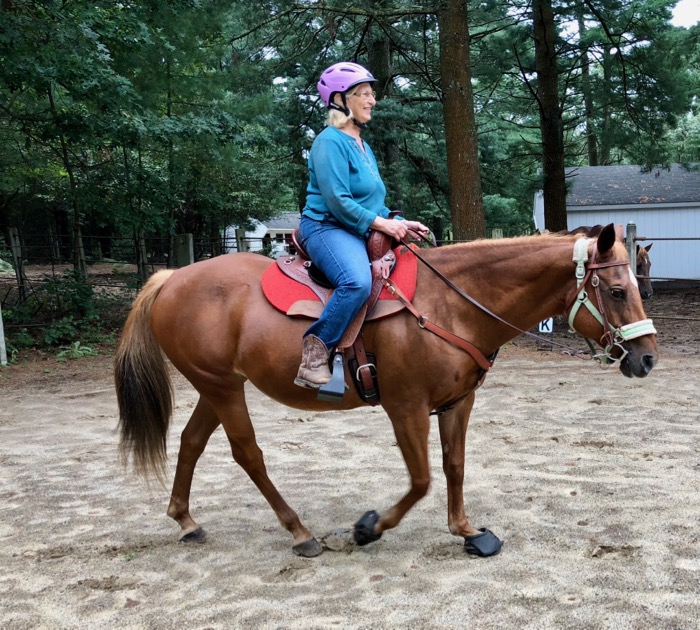Summer is a Quarter Horse who was rescued from the kill pen by Rita. She is one lucky mare. Rita is lucky, too, because Summer is a super little horse. Summer does, of course, have issues, but Rita accepts and accommodates them. In return, Summer adores her person.
I was called in to help resolve some of Summer’s behavioral issues in a way that is as kind and effective as possible. Summer has many years of history that she’ll carry forever. She can move quickly and gets suddenly anxious in certain situations. She also knows how to say no in a way that makes the rider want to scramble out of the saddle!
Keeping Rita and Summer safe is not as simple as substituting aversive methods with treats and using a clicker (read more about my thoughts on that here.) Summer is pre-laminitic, which means anything she eats has to be of a certain type and doled out sparingly. She has to be kept in solo turnout, on a bare lot. Rita provides (at her own cost, and filled by her) these excellent slow-grazers, but still, Summer has food anxiety. I can teach Summer to stand facing front and not move a whisker when being hand-fed, but that’s not going to create a relaxed trail horse.
But I have something better than food for Summer. I have Rita.
Before riding in the ring, Rita lets Summer wander about, nibbling at the bits of grass along the edge, and visiting over the fence with the horses in the bordering paddocks. Summer enjoys that, but always comes back and does this. Stands with her nose next to Rita’s face, and breathes on her.

Then Summer blinks her eyes, relaxes and naps.

Summer is telling us that Rita is her happy and safe place, and that she’s capable of self-calming when there. My job is to transfer that to situations outside of the arena, and then to when Rita is riding.
At this farm, you exit the ring down a short path and then get to a Y. Go left back to the barn, right to the wooded trail. At this Y, Summer always wants to go left. You can lead her right from the ground, and she’ll go, with reluctance. But if you’re on her, the energy bubbles up, she’ll wheel in a circle, and bolt for the barn.
We started by leading Summer, with halter and lead rope, to the Y. Take a step to the right. Pause. Wait for the letting go of tension. By our body language we let Summer know that she could be just as content and safe here as in the ring. You could see her unclench. Breathe. If Summer flared her nostrils and did little snorts. Rita stood next to her and waited. Summer self-calmed. Sometimes Rita give Summer permission to graze.
Then we walked on.

I worked with her once a week, and Rita did her homework. Summer gained confidence that she could put herself in that relaxed place, which she far prefers to be in than the world of perpetual worry. Summer started to believe that safety was not only at the barn, but also right there with her. In this photo, we had walked until the stable and the other horses were all out of sight. Grazing this calmly, in this place, was a huge achievement!

It’s essential not to get overconfident and to push it. Small differences in tack, weather, and environment, can affect your progress. At this point, we were doing the work in just the halter. I thought to see if things would change if the bridle were on. It did. In this photo, you can see flared nostrils and flicking ears. Summer associated the bridle with stressful trips away from home, so we hand-walked her in that, with the same protocols of waiting for calm, enjoying that moment, and then walking on, or grazing, until the bridle was no longer a trigger.

After a month, it was time to do this work from the saddle. The other day, I had Rita ride out of the ring to the Y. This was raising the criteria a lot, but I was prepared. Summer walked confidently, but I could see the nostrils flaring as we got to the choice in the path. There are times when I do use food, and this was one of them. I had horse cookies (low sugar and not too tasty), which I doled out to Summer as we walked, taking the right-hand path away from the barn. Summer didn’t wheel around, or back up, or do a rodeo move. Instead, after we progressed about fifteen feet past the Y, I stopped, and she stopped. Unlike in the past, where being in this place meant quivering muscles, Summer stood still and relaxed. Summer had learned that being calm is self-reinforcing! Rita got off and they had a companionable moment together.
Summer is a smart little mare. She’s quickly learning that being calm feels better and is less work than stressing out and heading back to the barn. She’s learning that being thoughtful is better than being reactive. Summer is intelligent and curious, and I think she’s going to learn to enjoy seeing the wider world, with her friend, Rita.



This is the loveliest thing I’ve read in a long time. Thank you for sharing this story and please extend my thanks to Rita and Summer.
I’ll see them later this week and will tell Rita. I do appreciate her letting me share her story.
What a great lesson for all of us, don’t you think? Calm is better and easier.
Calm is a good state to be in!
So nice that Rita was able to save Summer. They seem to have a great relationship and it shows that calmness and patience go a long way. Wonderful story, thankyou 🙂
You’re welcome! 🙂
Wonderful, I am on this same journey, and this is inspiring to me to keep on going. I feel very alone in the world, since I don’t use whips or aversives with my sensitive horse. This story has made me believe in myself again. Thank you for sharing, Terry. – Kim and Tash
Keep on, Kim!
thank you Terry for telling our story, and for your very observant skills in communication between both horse and rider to enable us to become more and more partners, I am becoming so much more attuned to my sweet mare and she, in turn, is becoming such a willing and trusting mare. Summer and Rita
Excellent learning experience. Wish there were more like you.
Thanks. By sharing my blog, you can help spread this perspective 🙂
I’m not sure who is luckier, Rita or Summer, but am I ever glad they found one another!
It is the sweetest relationship.